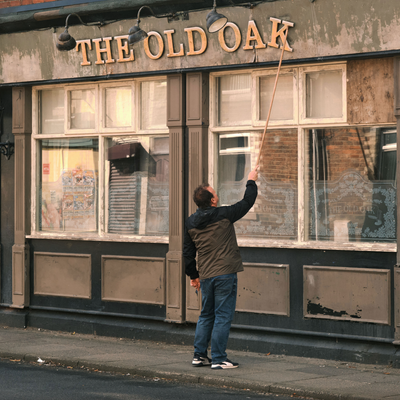
In 1984, the British filmmaker Ken Loach made one of his most beautiful and underdiscussed pictures, an hour-long television documentary called Which Side Are You On?, about the miners’ strikes that were gripping the United Kingdom at the time. Produced for the storied ITV series The South Bank Show, Loach’s film consisted mostly of songs and poems (and, occasionally, cartoons) written or performed in honor of the striking miners by ordinary workers and their families. Deemed too political for TV at the time, it did finally get shown after winning an award at the Berlin Film Festival. (You can watch it on YouTube here.) By that point, the strikes had already been broken — a defeat that forever undercut the British trade union movement and announced the victory of Thatcherism and unchecked capitalism.
Many would say that the ghosts of those miners’ strikes still haunt Britain today. They certainly haunt Loach’s latest and perhaps final film, The Old Oak, a spare and moving drama about a dying village in Northeast England that greets a group of Syrian refugees with a mixture of racism, contempt, and puzzlement. Framed photos from the strike adorn the abandoned back room of the titular local pub, which we are told is the last remaining gathering place in this depressed town after the closures of the church hall, the theater, and the community center. The pub’s owner, T.J. Ballantyne (played by Dave Turner, a retired fireman who belatedly began acting after consulting on Loach’s 2016 film, I, Daniel Blake), is himself the child of miners — he lost his father in an accident many years ago — and he’s one of the few in the village who don’t yell expletives or throw dirty stares at Yara (Ebla Mari) and her family as they arrive by bus in this strange new place.
The year is 2016 (pre-Brexit), and the economic despair surrounding these characters is one of the reasons why Yara and her family are here in the first place. The housing is dirt-cheap, and they’ve been placed there by a nonprofit organization that also provides them with basic needs, which in turn provokes the ire of impoverished neighbors who think these outsiders are leeching off other (presumably whiter) people in need. “Charity begins at home,” one pissy neighbor tells the kindly, overworked, exhausted volunteer Laura (Claire Rodgerson) as she brings the Syrians some bags of donations. “See what I’ve got? It’s nappies. There’s a baby,” she responds, making it clear that nobody’s gaming any system here — everybody’s just trying to survive on the barest essentials.
The Old Oak largely focuses on the growing friendship between T.J. and Yara, a relationship that starts in terse fashion. An amateur photographer who began by taking pictures in the refugee camp where she lived for two years, Yara wants to find the drunk hooligan who broke her camera when they first got off the bus so he can pay to have it fixed; T.J. knows who the man is, but he doesn’t want to get involved. As the guy who dutifully serves pints to whoever comes into his bar, including a gaggle of old chums who spend all day working themselves up into a lather about the immigrants invading their shores (they’re like a soused Greek chorus from hell), T.J. clearly doesn’t want to put himself out there one way or the other: “I say nowt, just keep me mouth shut,” he tells Laura as they drive around town in his van dropping off charity supplies to needy families. We know T.J.’s heart’s in the right place. He might not want to find the yob who broke Yara’s camera, but he will offer her one of his own. She doesn’t want another camera, however. The one she has was a gift from her father, who was taken from them back in Syria, his fate still unknown.
When his racist pals ask to use the back room to have a public meeting about how they’re feeling, T.J. coolly refuses: “There’s nay heating in there, the plumbing’s knackered, and the electrics are fucked, so that’s a nonstarter,” he tells them. He says much the same when Yara and Laura ask him if they can use it to bring the Syrians and local families together for a free meal. Of course, T.J. will eventually relent. We can tell that from the way he speaks lovingly of the miners’ strike and reflects on those black-and-white photographs in his run-down, abandoned back room, which slowly becomes a metaphor for the untapped power of community.
Loach has announced his retirement from filmmaking a couple of times in the past, and he did so again when The Old Oak premiered at Cannes last year. He does appear to mean it this time: The man is 87 years old, and he notes (correctly) that directing is arduous, physical work. The relative simplicity of The Old Oak’s narrative and its limited locations perhaps speak to that as well. The film has a graceful simplicity. Its cast of nonprofessionals (some of them refugees themselves) perform with little adornment or unnecessary emoting. The story and the situations it presents are sad enough; there’s no need for flashy expressions, no needy pleading for our sympathy.
Loach’s late period has been a lot more fruitful than most artists’. Of course, few films can compare to his early work, to the strident poetry and power of such masterpieces as Kes (1969), Cathy Come Home (1966), and Land and Freedom (1995), or to witty, gritty mid-period dramas like My Name Is Joe (1998) and Sweet Sixteen (2002) — movies that inspired generations of artists and activists. But the director’s later efforts have evinced a clarity that, at its best, makes for a compelling moral vision of modern life, in which political ideas emerge organically from the recognizable, everyday troubles depicted onscreen.
The Old Oak (which was written by Loach’s longtime collaborator Paul Laverty) completes a loose trilogy of works that began with I, Daniel Blake, a slow-burn drama about the Kafkaesque bureaucracy of Britain’s failing social safety net, and continued with 2019’s stomach-turning look at the gig economy, Sorry We Missed You, which followed the increasing humiliations faced by a middle-age e-commerce delivery driver. In those movies, the characters seemed to be hopelessly alone, their lives balkanized by ruthless, faceless systems that forced everyone to compete against one another — be it for a paycheck, a gig, or a social service.
By contrast, the people of The Old Oak slowly begin to realize that they have one another. If those other films were about the fragmentation of daily life, this one seems to understand that there is power in (a) union, as there was in Which Side Are You On?, with its portrait of collective art performed in the service of others in pubs and community centers all across Northern England. The new film also recalls Loach’s Jimmy’s Hall, another picture about the renovation of a gathering place intended to bring a divided, downtrodden populace together for camaraderie and understanding. As one of the characters in that film put it: “The language of brotherhood, it spreads like wildfire in a world of rampant greed.” With The Old Oak, Ken Loach goes out with one last, full-throated call for brotherhood and solidarity. It’s the most hopeful the old soldier’s been in years.
More Movie Reviews
- The Bone-Chilling Infested Is Spiders All the Way Down
- Anyone But You Has More Sex on Its Mind Than Your Average Rom-Com
- An Exploited Neighborhood, Seen Through Children’s Eyes





